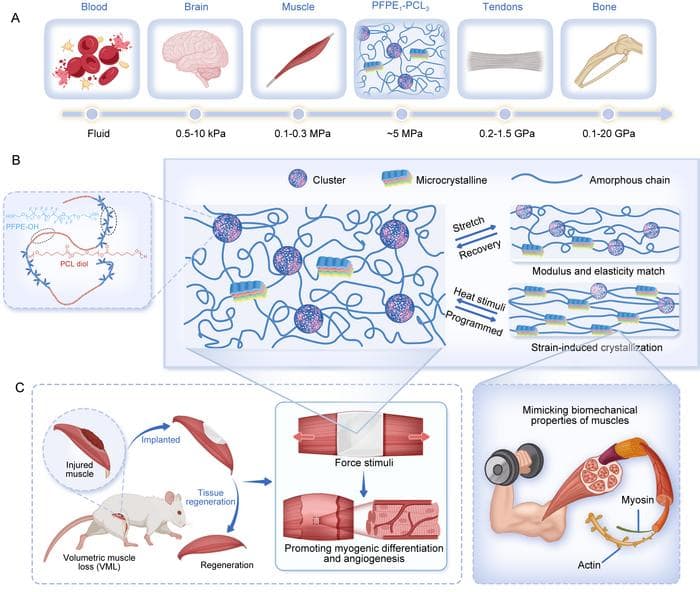Biomimetic artificial muscle advances treatment for severe muscle loss
A groundbreaking biomimetic artificial muscle that combines exceptional mechanical properties with tissue regeneration capabilities offers new hope for treating volumetric muscle loss injuries and improving prosthetic applications.

(A) A summary plot illustrating the elastic modulus range of the artificial muscle compared to representative biological tissues, highlighting the biomimetic mechanical properties of the artificial muscle. (B) A schematic representation of the designed multifunctional artificial muscle, showcasing its structural features tailored for enhanced functionality. (C) Demonstrations of the artificial muscle’s versatility: on the left, its ability to treat volumetric muscle loss by promoting myogenic differentiation and angiogenesis; on the right, its capacity to mimic the functional dynamics of natural muscle tissue.
© Cheng-Hui Li and Pengfei Zheng.
Researchers from Nanjing University and Nanjing Medical University have successfully developed a novel artificial muscle material that closely mimics natural muscle tissue properties through innovative molecular design. The material, based on block copolymerization of biocompatible perfluoropolyether (PFPE) and polycaprolactone diol (PCL), exhibits remarkable mechanical characteristics essential for muscle tissue engineering.
The research team, writing in National Science Review, explains that “biological materials exhibit great superiority in tailoring the extreme mechanical properties to simultaneously fulfil different functions. As an example, muscle tissues combine the properties of high mechanical strength, high stretchability, excellent tear resistance and resilience while still being soft.”
Breakthrough mechanical performance
The synthesized material demonstrates unprecedented mechanical properties, with a low elastic modulus (2-6 MPa) matching natural muscle tissue, while achieving ultra-high tensile strength (72.67 ± 3.19 MPa) and exceptional toughness (742.02 ± 23.98 MJ m−3).
“This artificial muscle combines low modulus and high toughness while successfully replicating the training enhancement and actuation functions of natural muscle, showing great potential in prosthetic actuators,” said Dr. Cheng-Hui Li from the School of Chemistry and Chemical Engineering at Nanjing University.
Enhanced regenerative capabilities
The researchers note that “an ideal scaffold material for VML treatment should possess mechanical and biochemical properties that are akin to those of muscle tissue, including biocompatibility, appropriate elasticity, toughness and mechanical strength to support normal muscle activities at the early stage.”
In vivo studies revealed significant potential for treating volumetric muscle loss. The material demonstrated excellent biocompatibility and promoted substantial muscle tissue regeneration within four weeks of implantation. Dr. Pengfei Zheng emphasized that “the exceptional elasticity, toughness, and softness of this artificial muscle allow it to flexibly interact with residual muscles.”
Histological evaluations showed well-organized regenerated muscle structure with contractile force comparable to normal tissue. The material also facilitated enhanced angiogenesis, crucial for successful muscle regeneration.
Revolutionary actuation performance
The artificial muscle exhibited remarkable shape memory and actuation capabilities, achieving actuation strains up to 600% and energy densities of 1450 J/kg. Under thermal stimulation, it demonstrated the ability to lift objects exceeding 5000 times its own weight and perform reliable reversible contraction and extension motions over multiple cycles.
The researchers highlight that “the multifunctionality and high efficiency of this artificial muscle highlight its importance in regenerative medicine and biomedical materials.”
Future implications
According to the research team: “This study explores the treatment of VML through the development of multifunctional artificial muscles. The synthesized materials exhibit essential mechanical properties including low elastic modulus, high tensile strength, and exceptional toughness, which are crucial for long-term tissue regeneration and prosthetic actuation.”
The authors conclude: “The artificial muscles that were developed in this study not only meet the immediate needs of patients who are suffering from VML, but also offer a promising pathway for developing next-generation biomaterials for muscle repair and prosthetic applications. This research provides a foundation for future technological advances and opens up new avenues for improving the quality of life for millions who are affected by severe muscle loss.”
Reference:
Qiu, P. F., Qiang, L., Kong, W., et. al. (22 November 2024). A soft, ultra-tough and multifunctional artificial muscle for volumetric muscle loss treatment. National Science Review, 12, nwae422. https://doi.org/10.1093/nsr/nwae422

